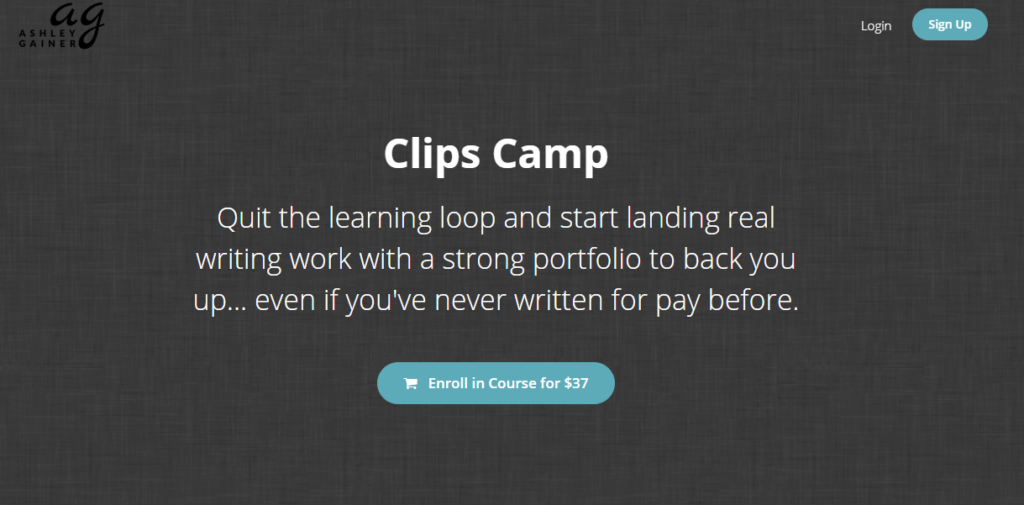If you’re thinking about creating your own online course, now is the perfect time to do it. Online course sales are approaching $1 billion dollars a day.
(Not that you’re in it for the money.)
This is indicative of a larger trend: Because of the pandemic, people have been sidelined; they have more free time to learn new skills.
Your course can help them build during a time that could have been reserved for disaster.
What a fantastic opportunity for you to use your unique expertise to bring value to others!
Don’t know what your online course should be about?
Start by asking yourself two key questions:
- What do I have a passion for that would change people’s lives?
- Would a good number of those people actually want to learn about it from me?
We’ll provide a dose of inspiration by sharing 12 top online course ideas and 74 niche course examples.
And we’ll also help you validate whether your idea is worth pursuing.
Before we get started, let’s get this out of the way…
You can’t do this just for the money.
You can’t do this because you want to build an online course business.
You can’t do this to change your life.
In case you missed it, the era of the personal brand expert who has cultivated a unique and impenetrable shell for sales of an idealistic course is over.
You must think customer first.
You must build the best content on the internet for that customer that directly solves their biggest problem, or you will fail. Everyone trying to do this is good.
You must be great — great at solving problems for your customers.
You can do it! And we can help. Let’s get started.
5 Reasons You Should Create An Online Course
We’ve already alluded to the reason some people create and market online courses: for money.
It’s understandable. It is quite a lucrative market.
But you should understand something important–unless you can provide content that is transformative for your audience, you aren’t the right person to build a course around the idea.
After all, you’re hoping to build strong relationships, where you’re the go-to resource for your customers.
By making that your primary objective, creating an online course ultimately helps you:
1. Build Your Brand
You want to position your business as the source for your target customers’ needs, right?
But first, you must build authority, trust, and recognition.
Sharing your knowledge in an online course is one way to start doing that.
And it’s a way to differentiate yourself, lending credibility to your expertise on the subject matter.
2. Extend Your Reach
You can reach a wider audience by offering an online course, particularly if you’re in a 1:1 customer-facing business, such as coaching or consulting.
And if you happen to create one of the best online business courses, you can extend that reach very quickly through referrals.
3. Create Lifetime Customers
Once you’ve proven you can meet their needs and solve their problems, your customers won’t want to look elsewhere.
So find ways to continually provide value.
Dive deeper into a subject area.
Or find another angle altogether.
Demonstrating a desire to meet their current and future needs creates customers for life.
4. Become A One-Stop-Shop
As you build authority and earn the trust of your audience, they’ll crave more knowledge.
You can expand your offerings and influence to include:
- books and ebooks
- speaking engagements
- interviews
- podcasts
- and more courses, of course 😊
5. Pay It Forward
Your reasons extend beyond provision for you and your family.
You want to use your expertise to change people’s lives.
Online courses can absolutely help you do this.
That’s what Mishael Porembski did.
She had a traumatic experience, and you want to help others who are facing something similar.
She searched for a holistic grief empowerment program after losing her husband shortly before the birth of her second child in 2007.
Unable to find one and in need of support, she created one herself.

She’s also written books, created videos, and facilitated local support chapters to help other women transform their lives after loss.
She decided to create an online course to address a pain-point for a specific audience, and because she was meeting a need, she was able to grow a business.
How Do I Choose The Best Online Course Topic For My Business? 3 Things To Do
When brainstorming ideas to create an online course, don’t overthink the obvious.
What I mean by this is that if others are doing a course on a subject, you probably could as well, especially if you’re able to speak on the topic more credibly.
You know this: for a course to be profitable, the subject must have a wide enough appeal, and courses that already exist are a great way to validate that an idea has that appeal.
Still, you must address a very specific need or solve an urgent problem.
You’ve probably heard the saying, “the riches are in the niches.”
It’s true when it comes to choosing online course subjects too.
It’s all about finding your audience’s sweet spot. If you manage to get it just right, students will flock to you.
Here’s how to choose the right topic:
1. Ask Your Customers For Online Course Ideas
Creating an online course, ideally, should be a collaboration with your intended audience.
You shouldn’t assume you know what they want.
You must ask them.
It’s a good idea to invite some trusted contacts from your professional network (who happen to be in your target niche) into the process too.
Ask what they think you’re particularly good at. Do they consider you their go-to on a particular subject?
This insight will help you hone in on an idea that aligns with your audiences’ needs and leverages your expertise.
What If I Don’t Really Know My Customers Yet
If you’re a new brand, you may still be getting to know your target audience.
But you should know who they are.
So try to get access to some of them if you can.
Use our Empathy Map to delve into their minds and the emotional position they’re coming from.

Offer the opportunity to help shape your brand with early access to a beta course offering.
What’s in it for them? They find a solution that speaks directly to their problems and pains.
And for you? By giving that special attention and a custom solution, you’ll likely earn customers for life.
2. Look At What’s Trending For Ideas To Create An Online Course
One way to find ideas to create an online course is to look at where your expertise meets trending topics.
Are you an enneagram expert?
Did you know the personality test is having a resurgence?
Meet your expertise with the market!
A great way to see what’s trending is to look at the most talked-about words on social media.
Because weighing your options as it relates to market size and profitability is an important part of the brainstorming process, trending topics can give you a headwind into an area that is hot right now.
Consider the bandwidth required to execute an excellent offering for a given topic, especially when looking at trends.
If it’s going to take a heavy lift to build a product for a trend, you might miss the trend. Look at all the folks who jumped on the bitcoin trading bandwagon.
So, use trends as a bellwether, but don’t be beholden to them.
Sometimes it does pay to be first. It is possible to find untapped potential within a market.
No one was looking for an iPod before Steve Jobs brought it to market. The same may be true about an online course in your expertise.
Google Search, Trends and Ads
To further gauge a course topic’s potential, head to Google.
Search for various keywords and pose questions someone might ask related to the topic you’re considering.
When Google returns tens or hundreds of millions of results, you’ll know it has wide appeal.
Running tests with Google Ads and checking Google Trends will further solidify which ideas would get the most engagement.
Be careful of false positives here.
Just because someone searches for a topic doesn’t mean they will pay for a product on the topic.
If you can, get people to validate your market by paying for a smaller offering on the topic — a paid webinar, for example.
Facebook Groups and Polls
If you aren’t a member of Facebook groups related to your business or industry, make sure to join them.
It’s a great way to keep your finger on the pulse of your target audience.
There you can create polls to gauge interest in your top online course ideas.
You’ll gain additional insight through group members’ individual posts and comments.
And when you recognize an opportunity to provide value, engage with them directly.
Be sure to acknowledge their pain and, after developing a dialog, offer potential solutions.
Use these interactions wisely. You get one chance at a first impression. So, when using groups, add value first! Then, and only then, engage in asking them for help in your course development.
3. Research Competitors’ Courses
If your competition offers its customers online courses, then there’s a good chance that you should as well.
The idea here is that if your competitor is offering a particular product, it’s likely that they’ve already done the research to validate the idea.
You can take advantage of their research!
Learn all you can about their offerings so that you can make yours better or more in-depth.
Consider the following:
- The breadth and depth of their course curriculum and whether you can go broader and deeper
- The cost and what’s included, such as access time, guarantees, etc.
- Course reviews that highlight the positives and negatives
If you aren’t sure you can build a better course, ask yourself if you can solve the main problem the customer is facing better.
Can you offer services like 1:1 coaching or an additional mini-course as an incentive?
Can you guarantee a certain result if they complete the materials?
Can you give them a refund if they don’t get everything they need from the product?
Can you steer certain potential customers to a better fit so they trust you as a provider of solutions?
Ultimately, there’s room for competitors in most markets.
So, think of ways to provide unique value that helps the customer. That’s the end goal here.
6 Steps to Selling Your Validated Course
At this point, you’ve done the necessary due diligence to move to the next phase.
You have a solid course idea and framework.
You’re confident you have a large enough pool of potential customers to draw from.
Now it’s time to start selling your course.
“Hold up there, boss, I’ve not built the course yet…” That’s ok!
Here’s why:
You need students now so you can gather constructive, early feedback.
It is the best way to ensure you’ll have a superior offering once it’s time for widespread release.
Here’s what you need to do to have an effective presale phase:
1. Create A Compelling Sales Page
Your sales page or landing page must convince prospective students to enroll in your course.
That means articulating a strong value proposition, one that solves a specific problem for your audience.
It should also include a course description, an outline, and any other information to persuade them to sign up.
Here’s a great example of a sales page that identifies a real pain or problem and offers a solution.

Problem: Aspiring writers often struggle to land work because they lack evidence of their expertise.
Solution: The Clips Camp course teaches students how to create a strong portfolio so they can stop wasting time and start getting clients.
2. Ramp Up Content Sharing (or continue doing so)
Making frequent, meaningful connections with your audience during the presale period is critical.
Write informative blog posts, make special announcements, and share other interesting content.
Keep your audience updated through your existing email list and all of your social platforms.
Each connection is an opportunity to remind them you’ve created a course that will solve their most pressing problem.
And (don’t miss this) every person should get value from your launch sequence. Everyone. Even if they don’t buy.
3. Keep Calling Customers To Action
Be sure to include a call to action in every connection you make.
You always want to give your potential customer a clear next step.
How?
Figure out low dollar commitments that they can make or give them free things in exchange for feedback.
We use tripwire offers, webinars, lead magnets, on-screen chat, automated email sequences, videos, and assessments to walk customers through our process.
Find out what works for you.
Each is an effective way to guide them to the next step in your sales funnel, which will ultimately lead to the final stage: purchase.
4. Analyze the Results from your Presale
Once you’ve pre-sold your target number of courses, it is time for you to sit back, listen, and learn.
Keep in close contact with your students as they work through each course section.
Gather feedback on what worked and what didn’t through online surveys or live Zoom sessions.
Then make necessary improvements to prepare for widespread release.
5. Set Up Affiliate Relationships
There’s a reason this is step 4. You likely shouldn’t start here.
This is time-consuming, and unless you have a clear plan for affiliates, you probably shouldn’t use this.
Still, at some point, you’ve probably identified other businesses that share, but don’t compete for, your customer base.
Reach out to those businesses and offer the opportunity for them to sell your products to their list for a share of the revenue those sales generate.
Before you do this, you need:
- To be able to track sales from specific sources
- To have a completed offering
- To have some conversion stats to share
- Swipe copy for them to use (suggested email, social, and sales copy)
Their support of your course helps build your credibility within the niche.
6. Thank Your Early Adopters
Be sure to thank your early adopters for their invaluable support.
They’ve helped you create a course worthy of widespread release.
Continue that partnership by offering incentives for positive testimonials about the results that they achieved after applying the teaching from your course.
For the best testimonials, you may even ask them to participate in future case studies to demonstrate or quantify your course’s impact on their business or lives.
And keep nurturing these relationships—these are the people you’ll rely on to help you create and market future course offerings.
12 Online Course Concept Ideas & 72 Niche Course Examples
Below are 12 top areas to focus on as you brainstorm online course topics.
Of course, you should choose an area that aligns with your business or personal expertise.
We’ve included five potential niche course ideas and a real-world course within each area to encourage the flow of ideas.
Some course creators entered a crowded, popular space while others elected for something quite niche.
So long as you address a specific pain or problem, yours can be successful.
1. Computers & Technology
- Cryptocurrency trading
- Learning coding as a new career
- Building your own website
- Managing your email inbox
- Home and small business networking
2. Business & Entrepreneurship
- Opening a new restaurant
- Inventions: from idea to launch
- Diversity training for private businesses
- Entrepreneurship for the common good
- Building a business with Pinterest
3. Personal Development
- Setting boundaries in relationships
- Reclaiming your life after divorce
- Building emotional intelligence
- Journaling for growth and empowerment
- Connecting with your intuition
4. Career & Professional Development
- Best careers according to your Enneagram
- Coaching for moms returning to the workforce
- How to lead an enterprise in 2020
- 21st-century resume writing and interview skills
- Optimizing your Linkedin profile
5. Content Creation
- Starting a blog
- Email marketing and sales funnels
- Creating sales pages
- Key copywriting skills
- Killer case studies
6. Education
- How to create an online course
- Conversational German
- Study skills for the reluctant student
- Vegetable gardening for beginners
- Personal finance for college-bound kids
7. Health & Fitness
- Yoga for a healthy back
- Prenatal diet for triplets
- Recovering from ACL reconstruction
- Caring for your newly diagnosed diabetic child
- Daily minimum fitness
8. Arts & Entertainment
- Creating professional home movies on your computer
- Building your pet’s Instagram presence
- Repurposed jewelry design
- Vintage photo art
- Screenwriting
9. Personal Finance & Money
- Retiring at 40
- Playing the credit card game
- Frugal living
- Purchasing your first income property
- Debt-free living
10. Side Hustles
- Turning a unique talent into a business
- Generating passive income
- Solid income through Upwork
- Writing e-books on Amazon
11. Family & Relationships
- Reconnecting with estranged family members
- Overcoming infidelity
- Parenting an introvert when you’re an extrovert
- Rekindling your empty-nester marriage
- Boundaries to teach your children
11. Science
- Interpreting consumer DNA test results
- Equipping your home for solar/smart home TK
- Forensics and the armchair detective
- Zero-waste living
- Green jobs and careers
Put Your Online Course Idea Into Action
The shift to remote working and stay-at-home orders have forced businesses to explore other ways to reach—and stay connected with—their audience.
Solopreneurs have also had to find ways to supplement income. Others have had to pivot to entirely new careers.
Creating and marketing an online course that provides value is a great way to leverage the knowledge and experience you’ve accumulated.
And there’s no need to be intimidated.
Yours doesn’t have to be the best online business course available on the market.
You don’t have to be an expert.
But you need to know your customer.
And you must solve a specific pain or problem.
And you must solve it better than anyone else.
With these ideas as inspiration, hopefully you’re ready to make it happen.

